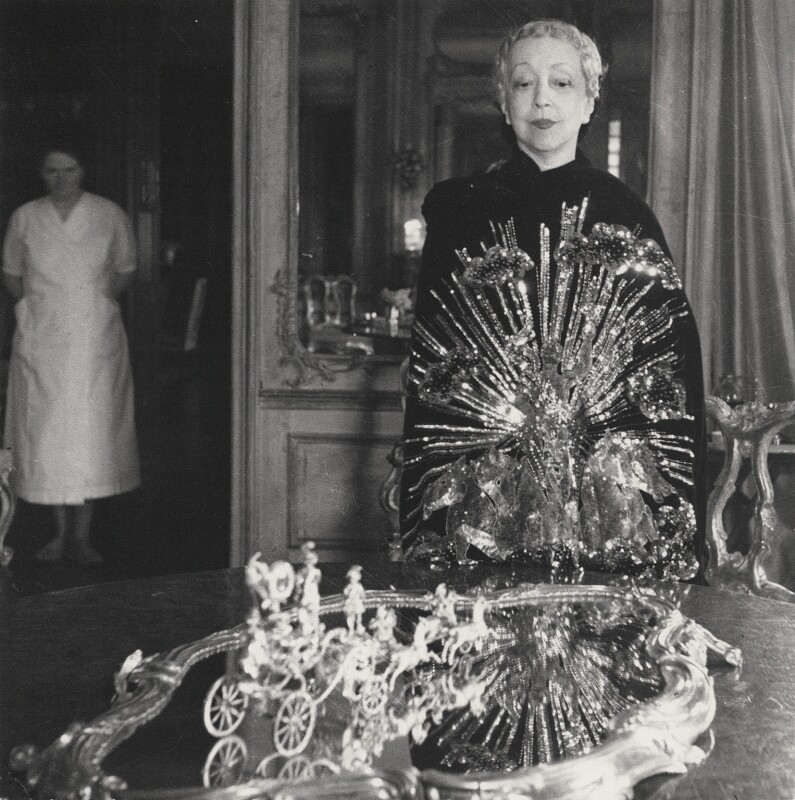Lady Mendl’s Elsa Schiaparelli “Apollo of Versailles” cape
The detailing in Elsa Schiaparelli’s “Apollo of Versailles” cape is exquisite. This piece comes from the iconic Autumn/Winter 1938-39 Cosmique collection, which was dedicated to “the worldly women.” Cosmique featured pieces with imagery inspired by the solar system, constellations and astronomy as well as historical events and figures. Schiaparelli took interest in astronomy because her uncle was a renowned astronomer. Elsa recalled in her autobiography Shocking Life, that he told her the beauty marks on her cheek resembled Ursa Major and would bring her luck. She went on to adopt the constellation as one of her personal trademarks and incorporated it into her designs for years to come.

This cape was imagined by Christian Bérard for actress and legendary decorator Lady Mendl (Elsie de Wolfe), who was a devoted Schiaparelli client. The Cosmique collection was Schiaparelli’s most opulent yet, as we see reflected in this lush piece. The embroidery on this black silk-velvet cape was created by Lesage in Paris. It was inspired by the Le Bassin d’Apollon at the Palace of Versailles, which was nearby de Wolfe’s beloved home, the Villa Trainon.

The cape features Greek sun-God Apollo raising his bow into the air while riding in his chariot. The five stallions gallop forward, leaving a trail of dust, all of which are backed by a giant sunbeam.

The clouds of dust at the stallion’s feet are mirror images of the clouds in the sky. Apollo, his bow, the stallions and outlines of the dust and clouds are comprised of petit round paillettes. The interior of the dust and clouds are dotted with silver round paillettes. Apollo’s chariot and clothing, as well as the horse’s teeth and manes were created using gold bugle beads. Gold metallic thread is used throughout.


The large sunburst shining from behind Apollo is by far the most eye-catching element of this cape. Schiaparelli used it multiple times in her other designs. It was created from alternating rows of gold and silver paillettes, interspersed with gold bugle beads and gold metallic thread.


This unique and over-the-top cape was absolutely fitting for Elsie de Wolfe who was one of the most fabulous women of her time. Born in 1865 in New York City, de Wolfe was educated in New York and Scotland. In 1883 she was presented at Queen Victoria’s court and made her way into London society. When she returned to live in NYC in 1884 she began to have charity fundraisers involving amateur theatricals. When her father died in 1890, the family became financially unstable and de Wolfe decided to use her connections to become an actress. She was assisted in finding work by her close friend Elisabeth Marbury who was a pioneering producer, theatrical and literary agent. The two had met at a party and lived together since. It was an open secret that they were in a lesbian relationship, which was quite controversial at the time. De Wolfe became very successful in theatre and even started her own company to produce shows on Broadway. In 1905 she retired from stage to pursue interior decorating at the urging of Marbury and Sarah Cooper Hewitt, who were both awed by her home decorating skills.
In the early twentieth century interior decoration was a male only field, but de Wolfe moved forward by using her connections to the rich and powerful. Her first project was designing the interior of New York’s Colony Club, which was the first social club for women. This was a smash success and established her reputation as America’s first female interior designer. According to The New Yorker, “Interior design as a profession was invented by Elsie de Wolfe.” She was celebrated as one of the most influential taste makers of the time.

Around 1906, Marbury and de Wolfe discovered an abandoned house in Versailles which they decided to buy and restore. It had been a part of the original Versailles palace complex, but was near ruins when they found it. The Villa Trainon was slowly transformed by de Wolfe into a dazzling paradise where lavish parties were held. Guest lists included movie stars, designers, royalty, heirs and ambassadors. Elsie’s extravagant summer balls were famous and one of the most exciting society events of the year. When WWI began, de Wolfe donated the Villa to the Red Cross to be used as a hospital to make sure it would be saved. She volunteered for twenty months as a front-line nurse and was eventually awarded the Croix de Guerre for her services during the war.

In 1926 de Wolfe shocked everyone by marrying Sir Charles Mendl at the age of 61. Mendl was a British diplomat in France, and the marriage was said to have been purely out of companionship and convenience for social connections. The two kept separate residences and de Wolf continued to live with and maintain her partnership with Elisabeth Marbury. During the Great Depression, de Wolfe continued to have elaborate themed parties like “Circus balls” in 1938 and 1939, but her interior design business was tanking. Photos of Lady Mendl wearing her Schiaparelli cape at her Paris home were taken around this time by Cecil Beaton.

When WWII began, Mendl fled France for Hollywood and continued to throw fabulous parties. After WWII she returned to her beloved Villa Trainon to restore it to life after Nazis had nearly ruined it during their occupation. She remained there until her death in 1950. In 1981 all contents of the home were put up for auction. Today the Villa remains in the hands of a private owner.
Lady Mendl’s Schiaparelli cape, labeled No.1, was gifted by her estate to the Met in 1951, and remains in their collection. It is a truly special piece that is as incredible as the woman it was created for.


A second version of this cape resides in Kyoto Costume Institute, inventory number AC9227 95-19-1.
Sources:
https://www.kci.or.jp/en/archives/digital_archives/1930s/KCI_199
https://www.metmuseum.org/art/collection/search/81142
https://www.britannica.com/biography/Elsie-de-Wolfe
https://www.newyorker.com/magazine/1938/01/15/handsprings-across-the-sea

